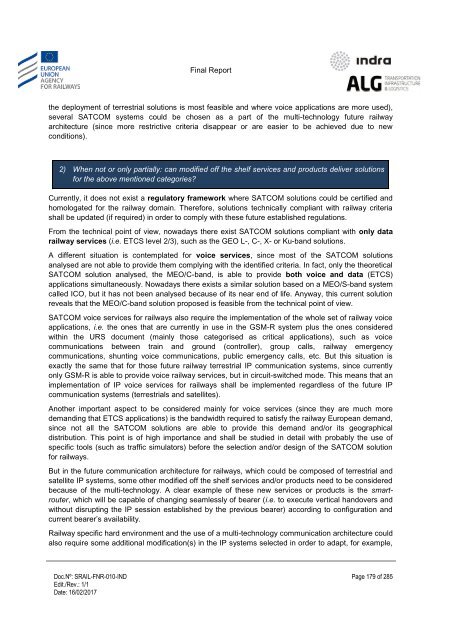Study on feasibility of SATCOM for railway communication
SRAIL-FNR-010-IND%20-%20FinalReport_v1.1_20170216
SRAIL-FNR-010-IND%20-%20FinalReport_v1.1_20170216
You also want an ePaper? Increase the reach of your titles
YUMPU automatically turns print PDFs into web optimized ePapers that Google loves.
Final Report<br />
the deployment <strong>of</strong> terrestrial soluti<strong>on</strong>s is most feasible and where voice applicati<strong>on</strong>s are more used),<br />
several <strong>SATCOM</strong> systems could be chosen as a part <strong>of</strong> the multi-technology future <strong>railway</strong><br />
architecture (since more restrictive criteria disappear or are easier to be achieved due to new<br />
c<strong>on</strong>diti<strong>on</strong>s).<br />
2) When not or <strong>on</strong>ly partially: can modified <strong>of</strong>f the shelf services and products deliver soluti<strong>on</strong>s<br />
<strong>for</strong> the above menti<strong>on</strong>ed categories?<br />
Currently, it does not exist a regulatory framework where <strong>SATCOM</strong> soluti<strong>on</strong>s could be certified and<br />
homologated <strong>for</strong> the <strong>railway</strong> domain. There<strong>for</strong>e, soluti<strong>on</strong>s technically compliant with <strong>railway</strong> criteria<br />
shall be updated (if required) in order to comply with these future established regulati<strong>on</strong>s.<br />
From the technical point <strong>of</strong> view, nowadays there exist <strong>SATCOM</strong> soluti<strong>on</strong>s compliant with <strong>on</strong>ly data<br />
<strong>railway</strong> services (i.e. ETCS level 2/3), such as the GEO L-, C-, X- or Ku-band soluti<strong>on</strong>s.<br />
A different situati<strong>on</strong> is c<strong>on</strong>templated <strong>for</strong> voice services, since most <strong>of</strong> the <strong>SATCOM</strong> soluti<strong>on</strong>s<br />
analysed are not able to provide them complying with the identified criteria. In fact, <strong>on</strong>ly the theoretical<br />
<strong>SATCOM</strong> soluti<strong>on</strong> analysed, the MEO/C-band, is able to provide both voice and data (ETCS)<br />
applicati<strong>on</strong>s simultaneously. Nowadays there exists a similar soluti<strong>on</strong> based <strong>on</strong> a MEO/S-band system<br />
called ICO, but it has not been analysed because <strong>of</strong> its near end <strong>of</strong> life. Anyway, this current soluti<strong>on</strong><br />
reveals that the MEO/C-band soluti<strong>on</strong> proposed is feasible from the technical point <strong>of</strong> view.<br />
<strong>SATCOM</strong> voice services <strong>for</strong> <strong>railway</strong>s also require the implementati<strong>on</strong> <strong>of</strong> the whole set <strong>of</strong> <strong>railway</strong> voice<br />
applicati<strong>on</strong>s, i.e. the <strong>on</strong>es that are currently in use in the GSM-R system plus the <strong>on</strong>es c<strong>on</strong>sidered<br />
within the URS document (mainly those categorised as critical applicati<strong>on</strong>s), such as voice<br />
communicati<strong>on</strong>s between train and ground (c<strong>on</strong>troller), group calls, <strong>railway</strong> emergency<br />
communicati<strong>on</strong>s, shunting voice communicati<strong>on</strong>s, public emergency calls, etc. But this situati<strong>on</strong> is<br />
exactly the same that <strong>for</strong> those future <strong>railway</strong> terrestrial IP communicati<strong>on</strong> systems, since currently<br />
<strong>on</strong>ly GSM-R is able to provide voice <strong>railway</strong> services, but in circuit-switched mode. This means that an<br />
implementati<strong>on</strong> <strong>of</strong> IP voice services <strong>for</strong> <strong>railway</strong>s shall be implemented regardless <strong>of</strong> the future IP<br />
communicati<strong>on</strong> systems (terrestrials and satellites).<br />
Another important aspect to be c<strong>on</strong>sidered mainly <strong>for</strong> voice services (since they are much more<br />
demanding that ETCS applicati<strong>on</strong>s) is the bandwidth required to satisfy the <strong>railway</strong> European demand,<br />
since not all the <strong>SATCOM</strong> soluti<strong>on</strong>s are able to provide this demand and/or its geographical<br />
distributi<strong>on</strong>. This point is <strong>of</strong> high importance and shall be studied in detail with probably the use <strong>of</strong><br />
specific tools (such as traffic simulators) be<strong>for</strong>e the selecti<strong>on</strong> and/or design <strong>of</strong> the <strong>SATCOM</strong> soluti<strong>on</strong><br />
<strong>for</strong> <strong>railway</strong>s.<br />
But in the future communicati<strong>on</strong> architecture <strong>for</strong> <strong>railway</strong>s, which could be composed <strong>of</strong> terrestrial and<br />
satellite IP systems, some other modified <strong>of</strong>f the shelf services and/or products need to be c<strong>on</strong>sidered<br />
because <strong>of</strong> the multi-technology. A clear example <strong>of</strong> these new services or products is the smartrouter,<br />
which will be capable <strong>of</strong> changing seamlessly <strong>of</strong> bearer (i.e. to execute vertical handovers and<br />
without disrupting the IP sessi<strong>on</strong> established by the previous bearer) according to c<strong>on</strong>figurati<strong>on</strong> and<br />
current bearer‘s availability.<br />
Railway specific hard envir<strong>on</strong>ment and the use <strong>of</strong> a multi-technology communicati<strong>on</strong> architecture could<br />
also require some additi<strong>on</strong>al modificati<strong>on</strong>(s) in the IP systems selected in order to adapt, <strong>for</strong> example,<br />
Doc.Nº: SRAIL-FNR-010-IND<br />
Edit./Rev.: 1/1<br />
Date: 16/02/2017<br />
Page 179 <strong>of</strong> 285


